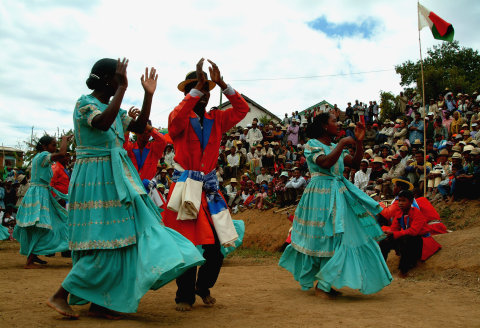After doing some research in the library over the past few
weeks, I stumbled upon a fascinating book called “The Lore of Madagascar” that
was published in 1994 by Edward L Powe, who visited Madagascar for several
months with the hopes of sharing his experiences globally. My goal is to create
a series of blog posts based on this book to explore some of the more
interesting aspects of Malagasy culture. I hope that these posts will enlighten
our study of Island biology and geography by providing cultural context.
 In my reading last night, I learned about Hira Gasy, a
six-hour festival that takes place in Antananarivo. With over 153 Hira Gasy
troupes in the capital city alone, this traditional festival has allowed the
Malagasy people to pass their morals through song, dance, and speech over
countless generations. The entire process contains ten steps, called the
prelude, Kabary, Fisaorana An Andriamanitra, Fiarahabana, Renin-Kira,
Famininana, Dihy, Vakon-Drazana, Zana Hira, and Fanaovam-Beloma, respectively.
The most intriguing of these segments to me was Renin-Kira, a fourty to sixty
minute segment during which the troupe sings, dances, and plays music to a tale
of morals in the Malagasy society. The Hira Gasy featured in the book was titled
“Respect your station in life, for it is short-lived,” and told of many
stories. One in particular followed a woman named Christy who committed
adultery when promised a Mercedes in exchange for breaking her marriage vows.
The song continues to chastise Christy, recount her errors, and recommend alternative
perspectives on being content with one’s lot in life. It is interesting to note
the pervasion of Western culture into the names and characters of a tradition
that, simultaneously, is distinctively Malagasy.
In my reading last night, I learned about Hira Gasy, a
six-hour festival that takes place in Antananarivo. With over 153 Hira Gasy
troupes in the capital city alone, this traditional festival has allowed the
Malagasy people to pass their morals through song, dance, and speech over
countless generations. The entire process contains ten steps, called the
prelude, Kabary, Fisaorana An Andriamanitra, Fiarahabana, Renin-Kira,
Famininana, Dihy, Vakon-Drazana, Zana Hira, and Fanaovam-Beloma, respectively.
The most intriguing of these segments to me was Renin-Kira, a fourty to sixty
minute segment during which the troupe sings, dances, and plays music to a tale
of morals in the Malagasy society. The Hira Gasy featured in the book was titled
“Respect your station in life, for it is short-lived,” and told of many
stories. One in particular followed a woman named Christy who committed
adultery when promised a Mercedes in exchange for breaking her marriage vows.
The song continues to chastise Christy, recount her errors, and recommend alternative
perspectives on being content with one’s lot in life. It is interesting to note
the pervasion of Western culture into the names and characters of a tradition
that, simultaneously, is distinctively Malagasy.
